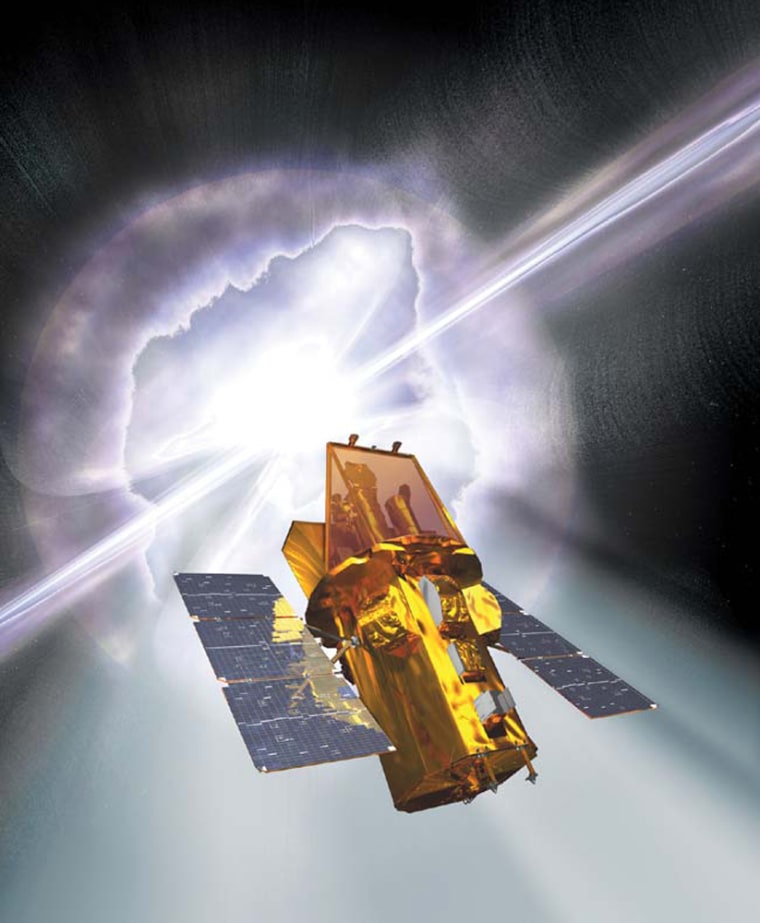An international team of astronomers is eagerly awaiting the launch of a new orbital observatory that will hopefully shed light on the most powerful explosions in the universe.
Just eight days away from launch, NASA’s Swift spacecraft is being readied for a mission to scan the sky for gamma-ray bursts, cosmic explosions that can burn with the intensity of billions of suns in less than a second. Researchers hope the mission will identify the trigger that sets off the bursts.
“I’m very anxious to get up there and start doing the science,” said Swift’s principal investigator Neil Gehrels, of NASA’s Goddard Space Flight Center (GSFC), in a telephone interview with SPACE.com. “It’s one of the most exciting things of my life.”
As its name implies, the Swift mission is designed for speed. Equipped with three telescopes to first detect - then observe – gamma-ray bursts, the spacecraft is designed to automatically detect the first flash of an explosion and then target itself at the event in about one minute.
That’s faster than any other satellite or ground-based system to date.
“[Swift] is the most autonomous spacecraft NASA has ever built,” explained Tim Gehringer, Swift’s deputy project manager at GSFC, during a prelaunch mission briefing earlier this month. “It’s a smart, capable spacecraft.”
Swift is currently slated to ride a Delta 2 rocket into orbit on Nov. 17 at 12:09 p.m. EST (1709 GMT) in a launch staged from Cape Canaveral Air Force Station in Florida. NASA, the Italian Space Agency and the Particle Physics and Astronomy Research Council in the U.K shared the mission’s total cost of about $250 million.
Solving the GRB mystery
Gamma-ray bursts, or GRBs, can be as long as a few minutes or as short as a few milliseconds, shedding intense gamma-rays in the initial explosion with an afterglow of X-rays and optical light that can fade over hours or weeks.
From Earth’s vantage point such bursts occur about once a day or so, and researchers believe the explosions are the death knells of massive stars that could then collapse into neutron stars or black holes.
“We think these bursts are the birth cries of black holes,” Gehrels said during the Nov. 1 prelaunch briefing, adding that exploring the GRB-black hole connection is one of Swift’s primary goals. “If you had gamma-ray glasses and looked out at the sky, gamma-ray bursts would dominate your experience.”
GRBs could also be triggered through more exotic means, such as the merging of two neutron stars or a black hole pair in orbit around one another.
Swift researchers hope their spacecraft will detect about one or two GRBs a week, or about 100 a year.
“We have now only been able to observe a couple of dozen or so bursts [total],” explained Swift mission operations director John Nousek, of Penn State University, during the briefing.
Researchers hope Swift may ultimately detect a total of about 500 bursts throughout the satellite’s multi-year lifetime. The spacecraft’s nominal mission spans two years, though it has an orbital lifetime of between eight and possibly 15 years, Gehrels told SPACE.com.
Self-targeting spacecraft
To find the GRB trigger, Swift will use its primary Burst Alert Telescope – laden with 32,000 detectors – to scan one-sixth of the sky at a time for GRB explosions.
Once detected, the spacecraft can determine the burst’s location in space and reorient itself accordingly between 20 and 75 seconds. It should then use a follow-up X-ray telescope and optical-ultraviolet instrument for additional measurements.
The observatory won’t keep the find to itself either.
“We have more than 40 observatories, space- and ground-based, to work with the Swift team to distribute this information,” Nousek said. “This rapid response is imperative.”
The spacecraft will be in continuous contact with ground controllers and relay its GRB find through the Gamma-ray Burst Coordinates Network (GCN) for distributions to telescopes, researchers and the public-at-large.
“This mission will generate the most comprehensive data set that we’ve ever had on GRBs,” Gehrels said. “Not only are we going to learn what causes the bursts, but we’ll be able to define a greater number of subclasses of bursts.”
For example, extremely short bursts lasting just fractions of a second are still a total mystery for Swift to study, especially since afterglows have so far only been detected in bursts lasting two seconds or more, researchers said.
The early universe
Swift may also offer researchers a glimpse at first stars to shine – and explode – in the universe.
Because GRBs are so bright, their gamma-ray signals can be detected from billions of light-years away, NASA researchers said. One light-year is the distance light travels in a year, about 6 trillion miles (10 trillion kilometers).
“We could be seeing bursts from the first generations of stars,” Gehrels said, adding that the heavy metal cores of such objects could make them more effective black hole generators. “These might be the most distant objects we have ever seen.”
